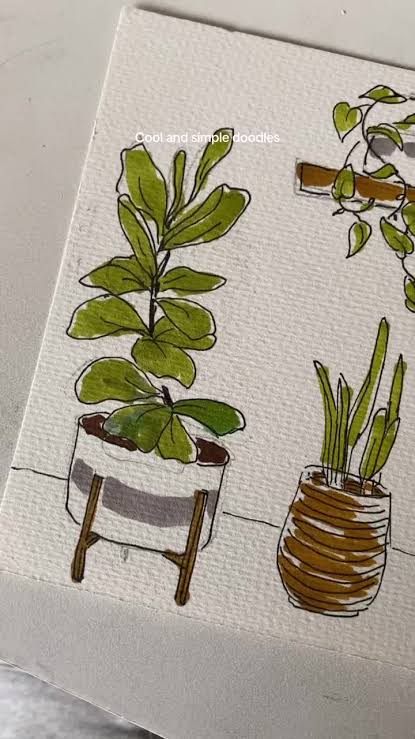Art and nature have always gone hand in hand — and one of the most calming, beautiful subjects to sketch is a plant. From lush tropical leaves to delicate flowers, plants offer endless inspiration for artists of all levels. It’s no surprise that everyone loves how to draw a plant — it’s relaxing, creative, and surprisingly easy once you learn a few simple techniques.In this guide, we’ll explore why everyone loves how to draw a plant, how you can start drawing plants today, and the little artistic secrets that make each leaf and petal come to life. Whether you’re in the United States, United Kingdom, or Canada, these tips will help you capture nature’s beauty right on your sketchpad.🌱 Introduction: The Joy of Drawing PlantsDrawing plants is more than just an art exercise — it’s a form of mindfulness. Each line, curve, and texture brings you closer to nature and helps you slow down from the rush of daily life.When people say they love drawing plants, what they really love is the process: the meditative flow of sketching organic shapes, the vibrant colors, and the satisfaction of watching something simple become beautiful.So, why does this trend continue to grow? Let’s find out exactly why everyone loves how to draw a plant!🎨 H2: The Beauty of Simplicity🍃 H3: Plants Are Beginner-FriendlyYou don’t need to be a professional artist to start. A few simple lines and shading can turn into a beautiful leaf or flower. Even basic doodles can look stunning!Start with easy shapes like:Rounded leaves (like monstera or pothos)Simple flowers (like daisies or tulips)Cacti or succulents (great for minimalists)✏️ H3: Minimal Tools, Maximum ResultsAll you need is a pencil, eraser, and paper. You can add color later using watercolor, markers, or digital art tools.The simplicity of materials makes plant drawing accessible for anyone, anywhere — whether you’re sketching in your backyard or at a cozy café.🌿 H2: How to Draw a Plant Step by Step🪴 H3: Step 1 – Observe Before You DrawLook closely at the plant’s shape, structure, and texture. Notice how the leaves curve or how the stem connects. This observation builds your drawing accuracy.🌼 H3: Step 2 – Sketch the Basic ShapesStart with light pencil strokes.Use circles or ovals for leaves.Draw lines for stems and branches.Keep it loose — perfection comes later!✍️ H3: Step 3 – Add DetailsOnce your base is done, add veins, folds, and shadows to bring it to life. Small touches make a huge difference.🌸 H3: Step 4 – Shade and ColorUse gentle shading to show depth. If you’re coloring, layer shades of green, yellow, or pink for a realistic look. Watercolor works beautifully for plants!These steps explain how to draw a plant in a simple, relaxing way that anyone can master.🌼 H2: Why Everyone Loves Drawing Plants🌿 H3: 1. It’s Calming and TherapeuticDrawing plants has a meditative rhythm — repetitive lines, soft shapes, and natural flow. It’s like mindfulness with a pencil!🌺 H3: 2. Endless VarietyFrom roses and sunflowers to ferns and succulents, no two plants are the same. Artists never run out of inspiration.🌳 H3: 3. Connects You With NatureIn today’s screen-filled world, drawing plants reminds us to slow down and reconnect with the natural world. It’s peaceful and grounding.🌵 H3: 4. Perfect for Every Art StyleRealistic, minimalist, cartoonish — plant drawings fit any aesthetic. You can keep it simple or make it intricate depending on your mood.🌻 H3: 5. Great for Creative ProjectsPlant drawings are perfect for journals, greeting cards, home decor, or tattoo designs. They’re universally loved for their beauty and symbolism.🖌️ H2: Tips for Perfecting Your Plant DrawingsStart small. Practice one leaf or flower before attempting a full plant.Use references. Take photos of real plants or find inspiration in nature books.Play with textures. Use shading or crosshatching to add depth.Try different mediums. Pencil, ink, watercolor, or digital — experiment to find your favorite.Observe light and shadow. Notice where light hits the leaves to create realistic highlights.Keep a plant sketchbook. Document your progress over time — it’s incredibly rewarding!These creative hacks will help you develop confidence and style while exploring how to draw a plant in your own unique way.🌼 H2: Fun Plant Drawing IdeasHouseplants: Monstera, pothos, or fiddle leaf figs.Wildflowers: Daisies, lavender, and poppies.Succulents & cacti: Perfect for clean, geometric art styles.Garden plants: Roses, tulips, and sunflowers.Fantasy plants: Create your own magical or alien-inspired designs!You’ll quickly see why people say everyone loves how to draw a plant — it’s creative freedom with endless possibilities.💡 H2: Why Drawing Plants Is TrendingPlant art is everywhere — on social media, home decor, and stationery. It represents growth, calmness, and creativity — three things people crave in modern life.In the U.S., U.K., and Canada, plant drawing workshops and online tutorials have become increasingly popular. It’s not just a hobby — it’s a lifestyle trend that brings art and mindfulness together.🌿 Conclusion: Embrace the Art of NatureIt’s easy to see why everyone loves how to draw a plant — it’s simple, relaxing, and endlessly inspiring. From beginners to professional artists, drawing plants offers a creative escape that connects you with nature while letting your imagination bloom.So grab your sketchbook, step outside, and let the beauty of the natural world inspire your next masterpiece. Once you start, you’ll realize just how magical it feels to bring leaves, flowers, and stems to life on paper. 🌸✏️

